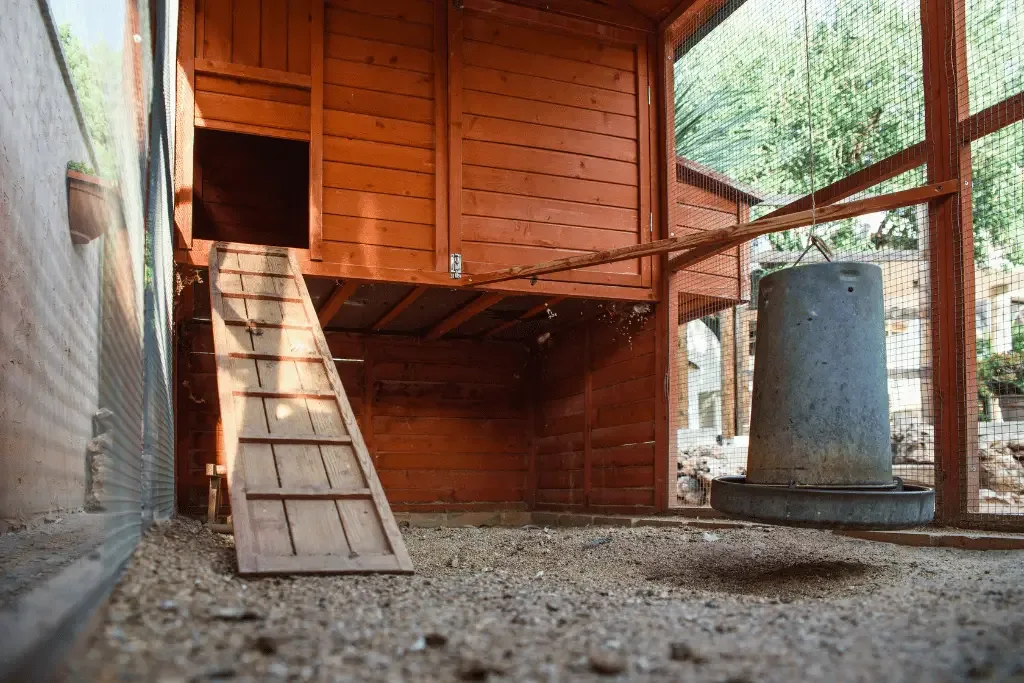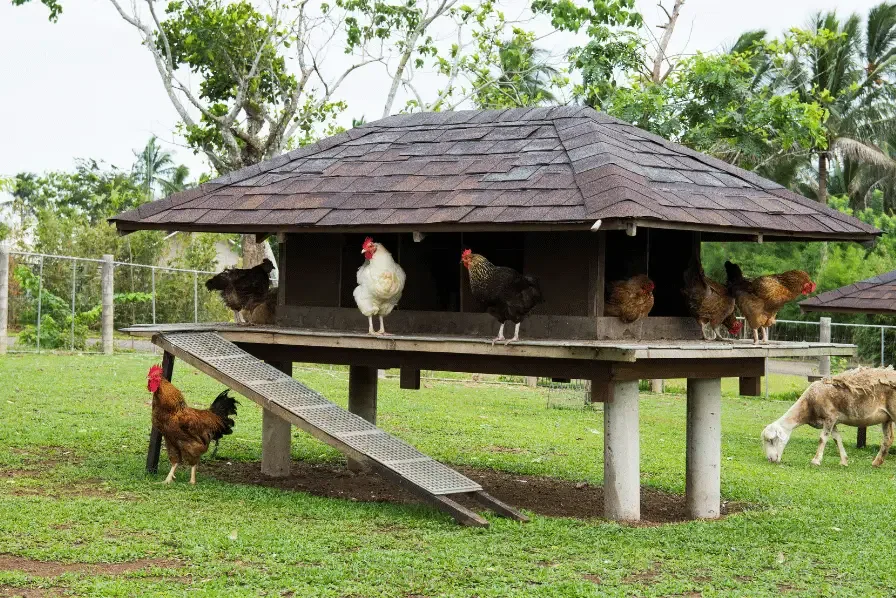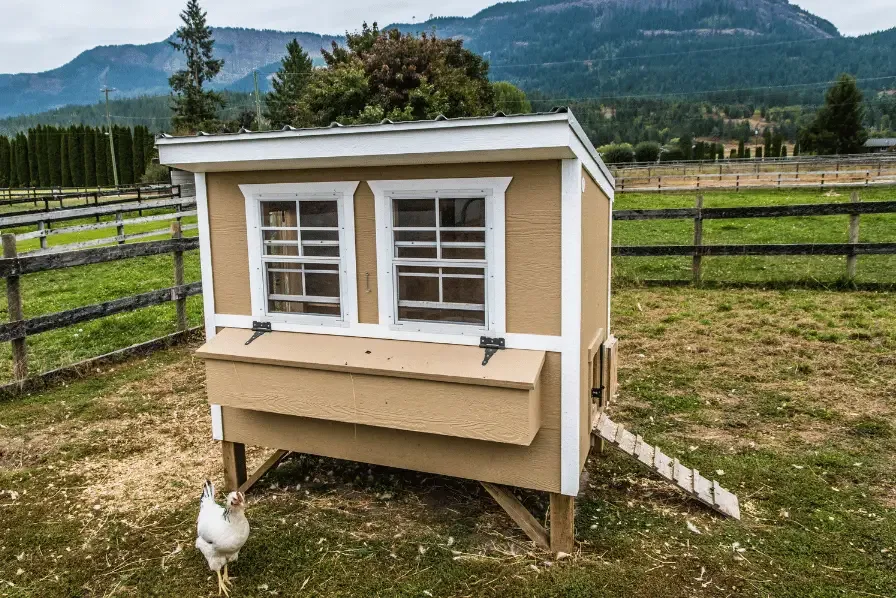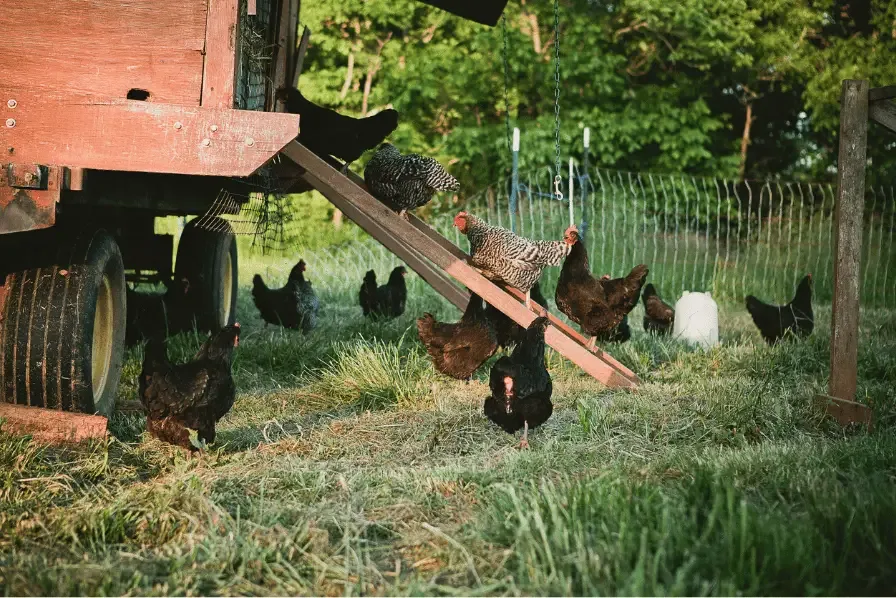Chicken coop ramps are an essential component of any chicken coop.
They provide a safe and easy way for chickens to get in and out of the coop, as well as access to elevated areas such as perches and nesting boxes.
A well-designed ramp can also prevent injuries and ensure the overall health and well-being of your chickens.
In this post, we will discuss:
- The importance of chicken coop ramps
- How to build a chicken coop ramp
- How to keep up with maintenance on chicken coop ramps
- Safety and things to keep in mind
- Frequently asked questions

Understanding Chicken Coop Ramps
When it comes to building a chicken coop, one of the most important considerations is the design of the ramp.
A well-designed ramp can make it easier for chickens to move in and out of the coop, while also ensuring their safety and comfort.
In this section, we’ll discuss some of the key factors to consider when designing a chicken coop ramp.
Importance of Ramp Angle and Steepness
The angle and steepness of the ramp are critical factors to consider when designing a chicken coop ramp.
If the ramp is too steep, it can make it difficult for chickens to climb up and down, which can lead to injuries.
On the other hand, if the ramp is too shallow, it can be difficult for chickens to maintain their footing, which can also lead to injuries.
As a general rule, the ideal angle for a chicken coop ramp is between 20 and 30 degrees.
This provides a good balance between ease of use and safety.
Additionally, the ramp should be wide enough to accommodate multiple chickens at once, but not so wide that they can’t maintain their footing.
Selecting the Right Materials
The materials used to build the ramp are also important.
The ramp should be sturdy enough to support the weight of multiple chickens, while also being easy to clean and maintain.
Some common materials used for chicken coop ramps include wood, plastic, and metal.
Wood is a popular choice because it’s easy to work with and relatively inexpensive.
However, it can be difficult to clean and may warp or rot over time.
Plastic is another option, but it can be slippery and may not provide enough traction for chickens.
Metal is a durable and easy-to-clean option, but it can be noisy and may get hot in the sun.
Design Considerations for Safety and Comfort
Finally, it’s important to consider other design factors that can impact the safety and comfort of the chickens.
For example, the ramp should be designed to prevent chickens from slipping or falling off the edge.
Additionally, it’s a good idea to include a landing area at the top of the ramp to give the chickens a place to rest before entering the coop.
Other design considerations might include the use of non-toxic materials, such as paint or sealant, to ensure the safety of the chickens.
Additionally, the ramp should be designed to be easy to clean and maintain, with no sharp edges or corners that could injure the chickens.

How to Build a Chicken Coop Ramp
Building a chicken coop ramp is an essential part of constructing a chicken coop.
A ramp allows the chickens to easily move in and out of the coop, and it also helps to prevent injuries.
Here’s a step-by-step guide on how to build a chicken coop ramp.
Determining the Appropriate Dimensions
Before starting the construction process, it’s important to determine the appropriate dimensions of the ramp.
The ramp should be wide enough for the chickens to comfortably walk up and down. A good rule of thumb is to make the ramp at least 12 inches wide.
The length of the ramp will depend on the height of the coop.
The slope of the ramp should be gentle enough for the chickens to easily walk up and down, but not too steep that they slip and injure themselves.
A slope of around 30 degrees is ideal.
Tools and Hardware Required
To build a chicken coop ramp, you’ll need the following tools and hardware:
- Saw
- Screws or nails
- Screwdriver
- Hinges
Step-by-Step Construction Process
- Cut the ramp boards to the appropriate dimensions.
- Cut the support boards to the same length as the ramp boards.
- Attach the support boards to the ramp boards using screws or nails.
- Attach the hinges to the top of the ramp.
- Attach the other end of the hinges to the chicken coop.
- Test the ramp to ensure it’s secure and stable.
How to Build Chicken Coop Ramps on a Budget
Building a chicken coop ramp doesn’t have to be expensive.
Here are a few tips on how to build a chicken coop ramp on a budget:
- Use scrap wood or pallets to build the ramp.
- Use recycled hinges or hardware.
- Use screws or nails you already have on hand.
- Find and take apart old furniture for pieces.
By following these simple steps, you can build a chicken coop ramp that is both functional and budget-friendly.

Ramp Features and Enhancements
When it comes to chicken coop ramps, there are a variety of features and enhancements that can make them safer and more functional for your feathered friends.
Here are some key elements to consider when building or upgrading your ramp.
Incorporating Traction Elements
One of the most important considerations for a chicken coop ramp is traction.
Chickens can easily slip and injure themselves on a smooth or slick surface, so it’s important to incorporate some sort of traction element into the ramp design.
This could include adding cleats or rungs to the ramp surface, using slats with gaps between them to allow for better grip, or even sanding the surface to create a rougher texture.
Weather-Resistant Treatments
Chicken coop ramps are exposed to the elements, so it’s important to choose materials and treatments that can withstand rain, snow, and other weather conditions.
This could include sealing the ramp with a weather-resistant coating or paint, using pressure-treated wood, or choosing a naturally weather-resistant material like cedar.
Accessibility for Different Chicken Breeds
Not all chicken breeds are created equal when it comes to navigating ramps.
Some breeds, like Silkies or some Frizzles, have feathered feet that can make it difficult for them to grip the ramp surface.
Others may be too heavy or too small to easily navigate a steep or narrow ramp.
When designing your ramp, consider the needs of the specific breeds of chickens that will be using it, and make adjustments as necessary to ensure that all of your birds can safely access their coop.
By incorporating traction elements, weather-resistant treatments, and accessibility features for different chicken breeds, you can create a safe and functional ramp for your feathered friends.
Maintenance and Upkeep
Maintaining and cleaning your chicken coop ramp is an important part of keeping your chickens healthy and safe.
Regular cleaning and inspection, repairing and replacing worn parts, and preventing and managing moisture and injuries are all essential to ensure the safety and well-being of your flock.
Here are some maintenance and upkeep tips for your ramp:
Routine Cleaning and Inspection
Regular cleaning and inspection of the chicken coop ramp is essential to ensure the health and safety of your flock.
The ramp should be cleaned at least once a week to remove any droppings, feathers, or debris that may have accumulated.
Use a stiff brush and a mild detergent to scrub the ramp thoroughly.
Rinse with water and let it dry completely before allowing your chickens to use it.
Inspect the ramp for any signs of wear and tear, such as cracks, splinters, or loose screws. Replace any damaged parts immediately to prevent injuries to your chickens.
Repairing and Replacing Worn Parts
Over time, the chicken coop ramp may become worn and damaged.
It is important to repair or replace any worn parts to ensure the safety of your chickens.
Check the ramp regularly for any signs of wear and tear, such as cracks, splinters, or loose screws.
Replace any damaged or worn parts immediately to prevent injuries to your chickens.
If the ramp is made of wood, it may need to be sanded and resealed periodically to prevent moisture damage.
If the ramp is made of plastic or metal, check for any signs of rust or corrosion and replace any damaged parts immediately.
Preventing and Managing Moisture and Injuries
Moisture can be a problem in chicken coops, especially in areas with high humidity, or if their waterer is located close to the ramp.
Moisture can cause the ramp to become slippery, which can lead to injuries to your chickens.
To prevent moisture buildup, ensure that the coop is well-ventilated and that the ramp is made of a material that is easy to clean and dry.
To prevent injuries, ensure that the ramp is not too steep and that it has a non-slip surface.
If the ramp is too steep, your chickens may slip and fall, which can cause injuries.
If the ramp does not have a non-slip surface, you can add a layer of sand or rubber matting to provide traction.

Integration with the Coop
When it comes to integrating a ramp with the chicken coop, there are a few important factors to consider.
This section will cover the key considerations when attaching the ramp to the coop door, ensuring secure and stable placement, and creating a landing area or porch.
Attaching the Ramp to the Coop Door
The first step in integrating a ramp with the chicken coop is to attach it to the coop door.
This can be done in a variety of ways, depending on the design of the coop and the ramp.
Some ramps may have hooks or brackets that can be attached to the door, while others may require screws or other hardware.
It is important to ensure that the ramp is securely attached to the coop door, as this will prevent it from shifting or falling when the chickens use it.
Additionally, the attachment should be strong enough to support the weight of the chickens as they climb up and down the ramp.
Ensuring Secure and Stable Placement
In addition to attaching the ramp to the coop door, it is important to ensure that the ramp is placed in a secure and stable location.
This will prevent it from tipping or shifting when the chickens use it, which could cause injury or stress.
When selecting a location for the ramp, consider the height of the coop and the doorway, as well as any obstacles or obstructions that may be underneath the ramp.
It may be necessary to adjust the height or angle of the ramp to ensure a secure and stable placement.
Creating a Landing Area or Porch
Finally, it is important to create a landing area or porch at the top of the ramp.
This will provide the chickens with a safe and comfortable place to enter and exit the coop, as well as a place to rest and socialize.
The landing area or porch should be large enough to accommodate multiple chickens at once, and should be elevated to the same height as the coop doorway.
Additionally, it should be free of obstacles or hazards, such as sharp edges or slippery surfaces.
By following these guidelines, you can ensure a safe and comfortable integration of the ramp within your chicken coop.
Special Considerations
Designing a chicken coop ramp requires careful consideration of the specific needs of the chickens that will be using it.
Here are some special considerations for chickens with specific requirements:
Ramps for Chicks and Older Chickens
When designing a chicken coop ramp, it is important to consider the age of the chickens that will be using it.
Chicks require a ramp with a shallow incline and a non-slip surface to prevent injuries.
Older chickens, on the other hand, may require a ramp with a steeper incline to accommodate their longer legs.
To create a ramp for chicks, consider adding a low lip or rail to prevent them from falling off the side.
For older chickens, a wider ramp with a textured surface can help them maintain traction and prevent slips and falls.
Designing for Chickens with Clipped Wings
Chickens with clipped wings may have difficulty navigating steep or narrow ramps.
To accommodate these chickens, consider designing a ramp with a wider base and a gentler incline.
Additionally, providing perches or steps at intervals along the ramp can give chickens with clipped wings a place to rest and regain their footing.
Ramp Solutions for Inclement Weather
Wet or icy conditions can make ramps slippery and dangerous for chickens.
To prevent injuries, consider installing a ramp cover or providing a non-slip surface such as rubber matting or sandpaper.
Additionally, positioning the ramp under a shelter can help protect it from wet weather and prevent it from becoming icy during winter months.

Safety with Chicken Coop Ramps
When it comes to keeping chickens, safety is a top priority.
This includes ensuring that your chicken coop ramps are safe and secure for your birds.
In this section, we will cover some important safety tips to keep in mind when building and using chicken coop ramps.
Preventing Slips and Falls
Chickens can be clumsy at times, and they are susceptible to slips and falls.
To prevent injuries, it is important to provide your chickens with a ramp that has good grip and traction.
This can be achieved by adding a non-slip surface to the ramp, such as rubber matting or sandpaper.
It is also important to ensure that the ramp is not too steep.
A steep ramp can be difficult for chickens to climb and can increase the risk of slips and falls.
A good rule of thumb is to keep the angle of the ramp at 30 degrees or less.
Protecting Against Predators
Predators are a major threat to chickens, and it is important to take steps to protect your birds from harm.
One way to do this is to ensure that your chicken coop ramp is secure and cannot be easily accessed by predators.
This can be achieved by adding hooks or latches to the ramp to keep it closed at night.
It is also important to ensure that the ramp is not too close to the ground, as this can make it easy for predators to climb up and attack your birds.
In addition to securing the ramp, it is also important to ensure that your chicken coop is predator-proof.
This includes using strong wire mesh to cover windows and doors and making sure that there are no gaps or holes that predators can use to gain access to the coop.
By following these safety tips, you can help ensure that your chickens stay safe and that your chicken coop ramp provides a secure and easy-to-use access point for your birds.
Final Thoughts
When choosing a chicken coop ramp, there are several factors to consider.
The size of your coop and the number of chickens you have will determine the size and slope of the ramp.
The material of the ramp is also important – it should be sturdy and slip-resistant to prevent injuries.
Additionally, the ramp should be easy to clean and maintain to ensure the health of your chickens.
Overall, a well-designed chicken coop ramp is crucial for the safety and health of your chickens.
Overall, taking the time to design and build a well-constructed ramp for your chicken coop can improve the safety and comfort of your feathered friends.
By following these tips and guidelines, you can ensure that your chickens have a smooth and easy transition from coop to yard!
Frequently Asked Questions
Do chickens need a ramp to their coop?
Chickens are not able to fly very high, so a ramp is necessary for them to access their coop.
Without a ramp, chickens may injure themselves trying to jump up to their coop or may be unable to access it altogether.
A ramp also makes it easier for chickens to move in and out of the coop, especially if they are carrying eggs or are injured.
How do you attach a ramp to a chicken coop?
Ramps can be attached to chicken coops in a variety of ways, depending on the design of the coop.
Some coops have pre-built ramp attachments, while others require the ramp to be attached using screws or brackets.
It is important to ensure that the ramp is securely attached to the coop and that it is at a suitable angle for the chickens to use comfortably.
What is the best ground for a chicken coop run?
The best ground for a chicken coop run is a solid, level surface that is free from sharp objects and debris.
Gravel, sand, and concrete are all good options.
It is important to regularly clean the coop run to prevent the build-up of droppings and to prevent the ground from becoming too wet or muddy.
How high off the ground should my chicken coop be?
Chicken coops should be at least 2-3 feet off the ground to provide adequate ventilation and to prevent predators from accessing the coop.
However, the exact height will depend on the size of the coop, the number of chickens, and the type of predators in the area.
It is important to research the specific requirements for your area and to consult with a local expert if necessary.
What are some creative design ideas for chicken coop ramps?
There are many creative design ideas for chicken coop ramps, including using recycled materials such as pallets or ladders, building a spiral ramp, or using different materials to create fun designs.
It is important to ensure that the ramp is safe and functional for the chickens to use, and to regularly inspect and maintain it to prevent any accidents or injuries.

